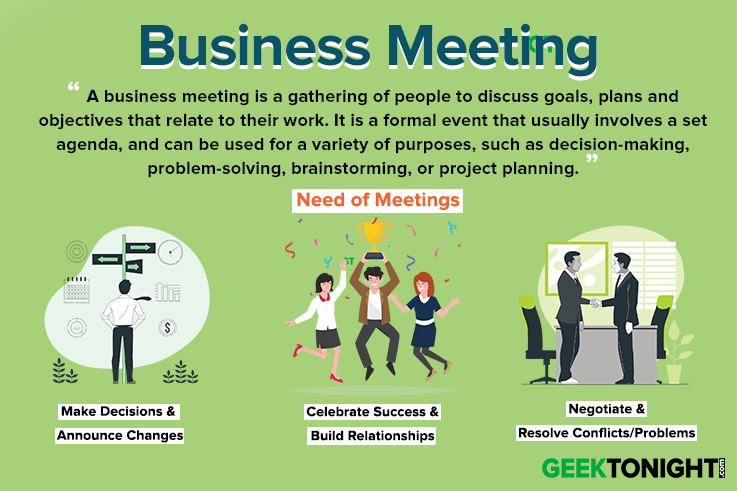How To Conduct A Business Meeting
To conduct a business meeting, create an agenda, invite participants, set a date and time, and follow the meeting structure for effective communication and decision-making. Conducting a business meeting is an essential task for any organization to collaborate, discuss ideas, and make decisions.
However, without proper planning and execution, meetings can turn unproductive and wasteful. To ensure that meetings are efficient and fruitful, it is crucial to follow a structured approach. This article will provide insights on how to conduct a business meeting successfully.
From creating an agenda to inviting participants and setting a date and time, each step contributes to effective communication and decision-making. By implementing these strategies, you can transform your meetings into valuable opportunities for collaboration and progress.
Setting The Agenda
Setting the agenda is a crucial step in conducting a successful business meeting. It helps to define the objectives and goals of the meeting, ensuring that it stays focused and productive. By creating a well-structured agenda, you can provide clarity to participants, identify the necessary attendees, and make the most efficient use of everyone’s time.
Defining The Meeting Objectives
When defining the meeting objectives, it’s important to be clear and concise, ensuring that everyone understands the purpose of the meeting. This helps to set expectations and keep the discussion on track. Start by asking yourself what you hope to achieve through this meeting. Are you looking to brainstorm ideas, make decisions, or provide updates? Clearly define the main objectives and communicate them to the attendees.
Identifying The Required Attendees
Identifying the required attendees is essential to ensure that the right people are present at the meeting. Consider who can contribute to the discussion and help achieve the meeting objectives. Avoid inviting individuals who are not essential to the topics being discussed, as this can result in unnecessary distractions and time wastage. Take into account the roles and responsibilities of potential attendees and select those who have the necessary expertise and knowledge.
Use the table below to guide you in identifying the required attendees for different meeting objectives:
| Meeting Objective | Required Attendees |
|---|---|
| Brainstorming ideas | Key decision-makers, team members, subject matter experts |
| Making decisions | Key decision-makers, stakeholders, individuals affected by the decisions |
| Providing updates | Team members, project managers, relevant stakeholders |
Once you have identified the required attendees, send out the meeting invitations, including the agenda and clear instructions on how to join the meeting. This ensures that everyone is prepared and knows their role in the discussion.
By setting a clear agenda, defining the meeting objectives, and identifying the required attendees, you can ensure that your business meetings are focused, productive, and achieve their intended purpose. Remember to share the agenda ahead of time, give participants the opportunity to prepare, and stay focused on the objectives throughout the meeting.

Credit: www.ringcentral.com
Preparing The Materials
To conduct a successful business meeting, thorough preparation of materials is essential. This involves organizing relevant documents, presentations, and reports, ensuring everything is easily accessible and well-structured. A well-prepared meeting sets the stage for productive discussions and effective decision-making.
Preparing the materials for a business meeting is an essential step to ensure the smooth flow and effectiveness of the discussion. By gathering necessary documents, creating presentations or handouts, and organizing everything in a structured manner, you can ensure that all participants are well-informed and on the same page. Let’s explore these steps in detail.Gathering Necessary Documents
Gathering necessary documents is the first step in preparing for a business meeting. This includes important reports, statistics, financial statements, or any other relevant information that will be discussed during the meeting. Make sure to compile these documents in a clear and concise format, ensuring that the information is easily accessible for everyone involved.Creating Presentations Or Handouts
Creating presentations or handouts is an effective way to visually convey information during a business meeting. PowerPoint presentations or handouts can be used to highlight key points, provide visual aids, and create a more engaging and interactive discussion. When creating presentations or handouts, consider using bullet points, diagrams, graphs, or charts to simplify complex information and make it easier for participants to grasp. To ensure that your presentations or handouts are effective, keep them concise and focused. Use bold headings and subheadings to organize the content, and avoid overwhelming the audience with excessive text or unnecessary details. Use clear and legible fonts, and choose a professional and visually appealing layout.Ensuring Each Heading Adheres To Html Syntax
When structuring your blog post for WordPress, it is important to adhere to HTML syntax guidelines. This ensures that each H3 heading is properly formatted and recognized by the WordPress editor. In HTML, the syntax for an H3 heading is as follows: “`Heading Text
“` By following this format, you can maintain consistency and readability in your blog post, making it easier for readers to navigate and comprehend the content. In conclusion, preparing the materials for a business meeting is crucial for effective communication and successful outcomes. By gathering necessary documents, creating presentations or handouts, and adhering to HTML syntax, you can ensure that your meeting is well-organized and engaging. Remember to keep the content concise, visually appealing, and easily accessible for all participants.Choosing The Right Location
When it comes to conducting a business meeting, one of the crucial factors to consider is choosing the right location. The location you select can play a significant role in the overall success of the meeting. From the size of the meeting to the facilities provided, there are several aspects to keep in mind. Let’s take a closer look at some key considerations to ensure you choose the perfect location for your business meeting.
Considering The Size Of The Meeting
Before selecting a venue, it’s essential to consider the size of the meeting. Take into account the number of attendees you expect to have and ensure the location can comfortably accommodate everyone. A cramped space can hinder productivity and make participants feel uncomfortable. Conversely, a large venue for a small meeting may create an impersonal atmosphere. Choosing an appropriately sized location ensures that all attendees have sufficient space to move around and interact with each other effectively.
Selecting A Venue With The Required Facilities
Another crucial aspect to consider when selecting a meeting location is the availability of required facilities. Make a list of the specific amenities and equipment you’ll need during the meeting and ensure the venue can provide them. This may include projectors, screens, audio systems, whiteboards, and internet connectivity. Checking for the presence of these facilities in advance can save you from any last-minute hassles and allow the meeting to proceed smoothly.
Using A Table To Compare Locations:
| Facilities | Venue A | Venue B | Venue C |
|---|---|---|---|
| Projector | ✓ | ✓ | ✗ |
| Audio System | ✓ | ✗ | ✓ |
| Whiteboard | ✓ | ✓ | ✓ |
| Internet Connectivity | ✓ | ✓ | ✗ |
Comparing the facilities offered by different venues can help you make an informed decision. Evaluate each venue based on the specific needs of your meeting, ensuring that all the necessary amenities are available.
By carefully considering the size of the meeting and selecting a venue with the required facilities, you can set the stage for a successful business meeting. An appropriately sized location and the availability of essential amenities contribute to a productive and engaging atmosphere, allowing participants to focus on the agenda at hand rather than being distracted by any logistical issues.

Credit: preply.com
Facilitating Effective Communication
To conduct a successful business meeting, effective communication is essential. Encouraging active participation, managing time, and keeping discussions focused are crucial elements for ensuring productive collaboration. By following these strategies, you can optimize communication and achieve the desired outcomes in your business meetings.
Encouraging Active Participation
In order to have an engaging and fruitful business meeting, it is important to encourage active participation from all participants. By fostering an inclusive environment where everyone feels valued and their opinions are respected, you can stimulate meaningful discussions and generate innovative ideas.
Here’s how you can encourage active participation:
- Start the meeting by setting a positive tone and clearly communicating the objectives.
- Provide opportunities for everyone to share their thoughts and ideas.
- Listen actively to each participant and acknowledge their contributions.
- Encourage open dialogue and create a safe space for constructive criticism.
- Facilitate brainstorming sessions to encourage creative thinking among the participants.
- Ensure that quieter individuals are given an equal chance to express their viewpoints.
Managing Time And Keeping The Discussion Focused
Time management is crucial for the success of any business meeting. By establishing clear agendas, setting time limits for each agenda item, and keeping discussions focused, you can ensure that your meetings stay on track and achieve their objectives.
Here are some effective strategies to manage time and keep the discussion focused:
- Create a detailed agenda and distribute it to all participants before the meeting.
- Assign time limits to each agenda item and stick to them.
- Set ground rules for the meeting to maintain order and prevent off-topic discussions.
- Encourage participants to stay on point and redirect the conversation if it veers off track.
- Use visual aids, such as slides or charts, to support the discussion and enhance understanding.
- Summarize key points throughout the meeting to ensure clarity and alignment.
By implementing these strategies, you can conduct business meetings that are efficient, engaging, and result-oriented. Effective communication plays a vital role in improving team collaboration and achieving desired outcomes. Start applying these techniques in your meetings, and you’ll witness the positive impact they have on your business.
Concluding The Meeting
In concluding the meeting, it is important to summarize the key decisions and action items that were discussed. This helps to ensure that everyone is on the same page and understands their responsibilities moving forward.
Summarizing Key Decisions And Action Items
Summarizing the key decisions and action items provides a clear and concise overview of what was discussed and agreed upon during the meeting. This summary can be shared with all attendees and stakeholders to keep them informed.
Key decisions and action items should be stated in a straightforward and easy-to-understand manner. This helps to avoid any confusion or misinterpretation later on. It is important to use clear and concise language and avoid any unnecessary jargon or technical terms.
Consider using a table to present the key decisions and action items. This can help to organize the information and make it easier to digest. The table should include the decision or action item, the person responsible, and the deadline for completion.
| Decision/Action Item | Person Responsible | Deadline |
|---|---|---|
| Implement new marketing strategy | Marketing Team | End of the month |
| Set up monthly performance reviews | HR Department | First week of each month |
| Research new suppliers | Purchasing Team | By next week |
Scheduling Follow-up Meetings If Necessary
If there are unresolved issues or additional topics to discuss, it may be necessary to schedule follow-up meetings. This ensures that all important matters are addressed and no loose ends are left hanging.
When scheduling follow-up meetings, consider the availability and preferences of all participants. Use a collaborative scheduling tool or simply ask the attendees for their preferred dates and times.
Once a suitable date and time have been determined, send out a calendar invitation or email to all participants. Include the purpose of the meeting and any necessary preparation or documents required.
Remember to record the follow-up meeting in your organization’s calendar and set reminders to ensure that it is not overlooked or forgotten.
In the event that follow-up meetings are not necessary, communicate this to the relevant parties and make sure that any outstanding action items are assigned and clarified.

Credit: www.geektonight.com
Frequently Asked Questions On How To Conduct A Business Meeting
How Can I Effectively Manage Time During A Business Meeting?
To effectively manage time during a business meeting, set a clear agenda, stick to scheduled time-slots, and encourage focused discussions.
What Are The Key Elements Of A Successful Business Meeting?
The key elements of a successful business meeting include a clearly defined purpose, active participation, effective communication, and actionable outcomes.
How Can I Engage Participants And Ensure Their Active Involvement?
To engage participants and ensure active involvement, encourage open dialogue, ask for input and feedback, assign roles, and provide interactive activities or brainstorming sessions.
Conclusion
To wrap up, conducting a business meeting requires careful planning, effective communication, and strong leadership. By following these steps, you can ensure that your meetings are productive and efficient. Remember to set clear objectives, create an agenda, engage all participants, and provide clear follow-up actions.
By implementing these strategies, you can maximize the impact of your business meetings and drive success for your organization.





